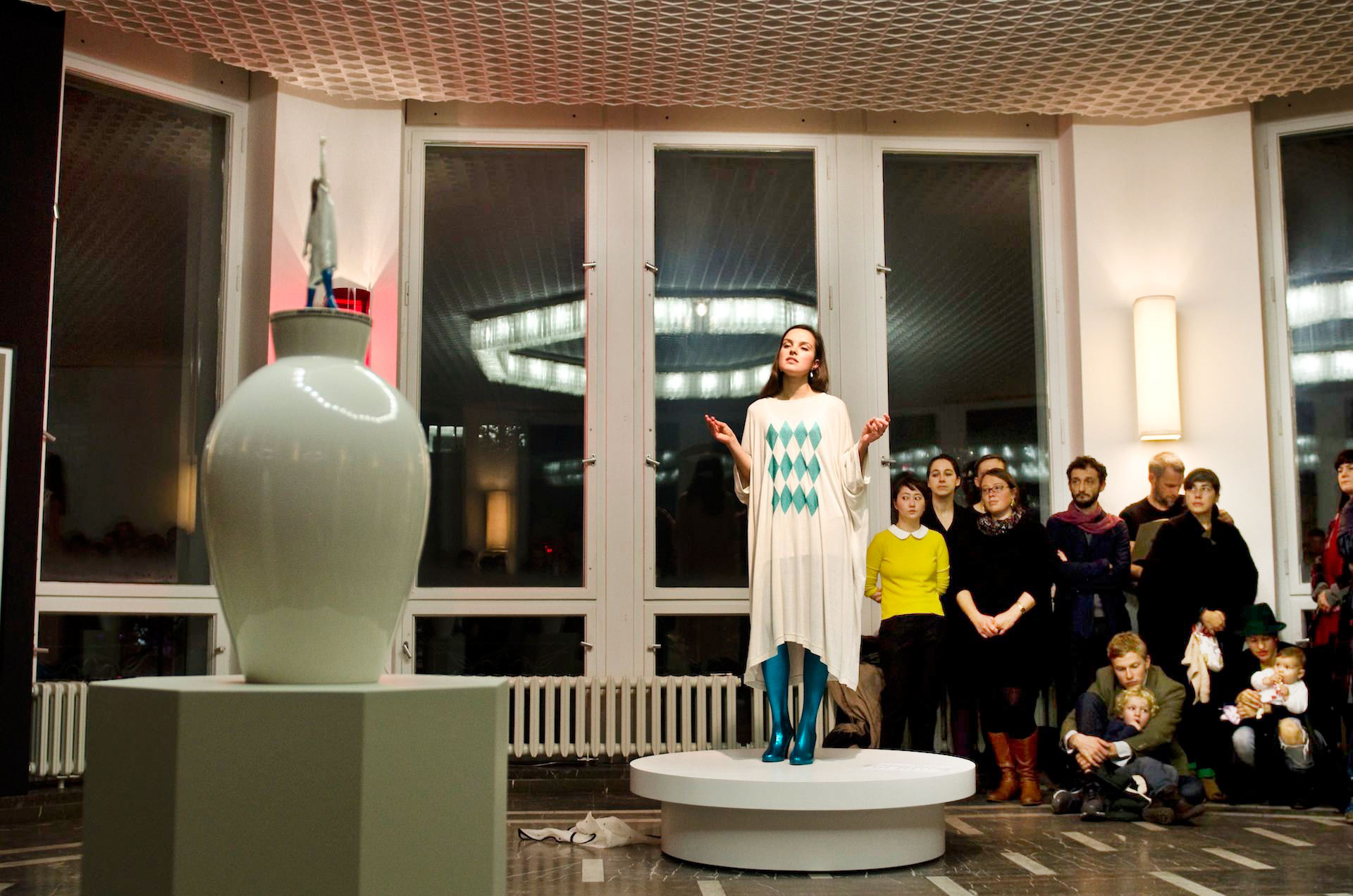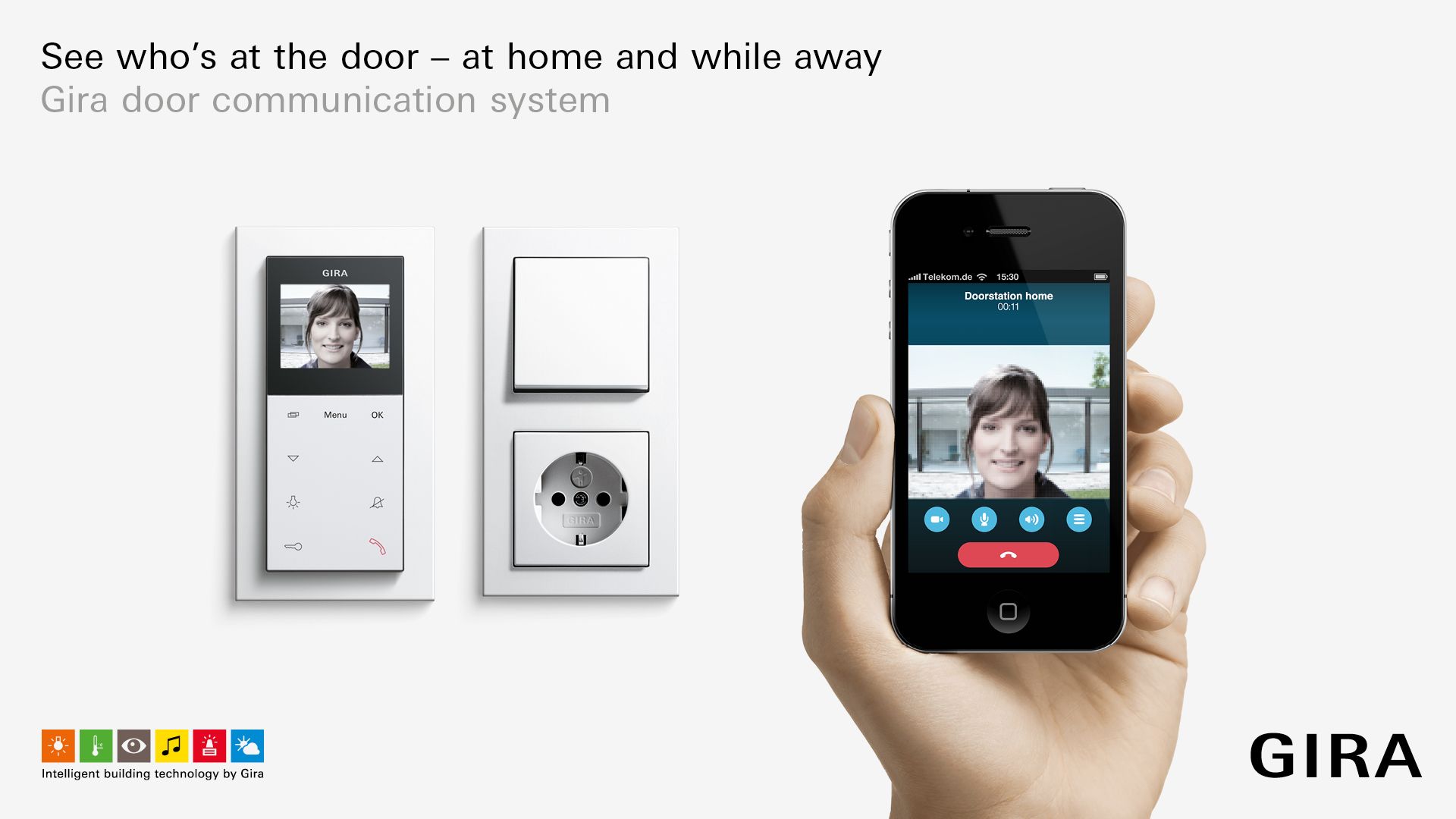-
360°
View
In the Schinkel Pavilion with Nina Pohl
Interview by Elvia Wilk(Photo: Chloé Richard)
-
The Schinkel Pavillon is a classical-looking glass-walled rotunda situated in a former palace garden just off Unter den Linden, with grand views of some of city’s key historical landmarks. It’s a typical piece of Berlin architecture in many ways – an amalgamation of historical styles and materials and functions. Built in 1969 by the modernist DDR architect Richard Paulick, the pavilion’s façade contains terracotta elements salvaged from the nearby Bauakademie – constructed in 1836 by the renowned architect Karl-Friedrich Schinkel, but later bombed in 1945 and demolished in 1962.
Dressed in cannibalized Prussian décor and an iconic Prussian name, the pavilion was once a venue for GDR cocktail parties before the Wall came down. Now it is a public contemporary art space hosting exhibitions and events, but like many buildings in the city it’s about to get crowded in by one of the countless private development schemes jostling for prime real estate acreage. We talked to Nina Pohl, curator of the Schinkel Pavillon since 2007, about the history of the building, its life as an arts space, and how its increasingly claustrophobic urban situation is indicative of Berlin’s development as a whole.
-
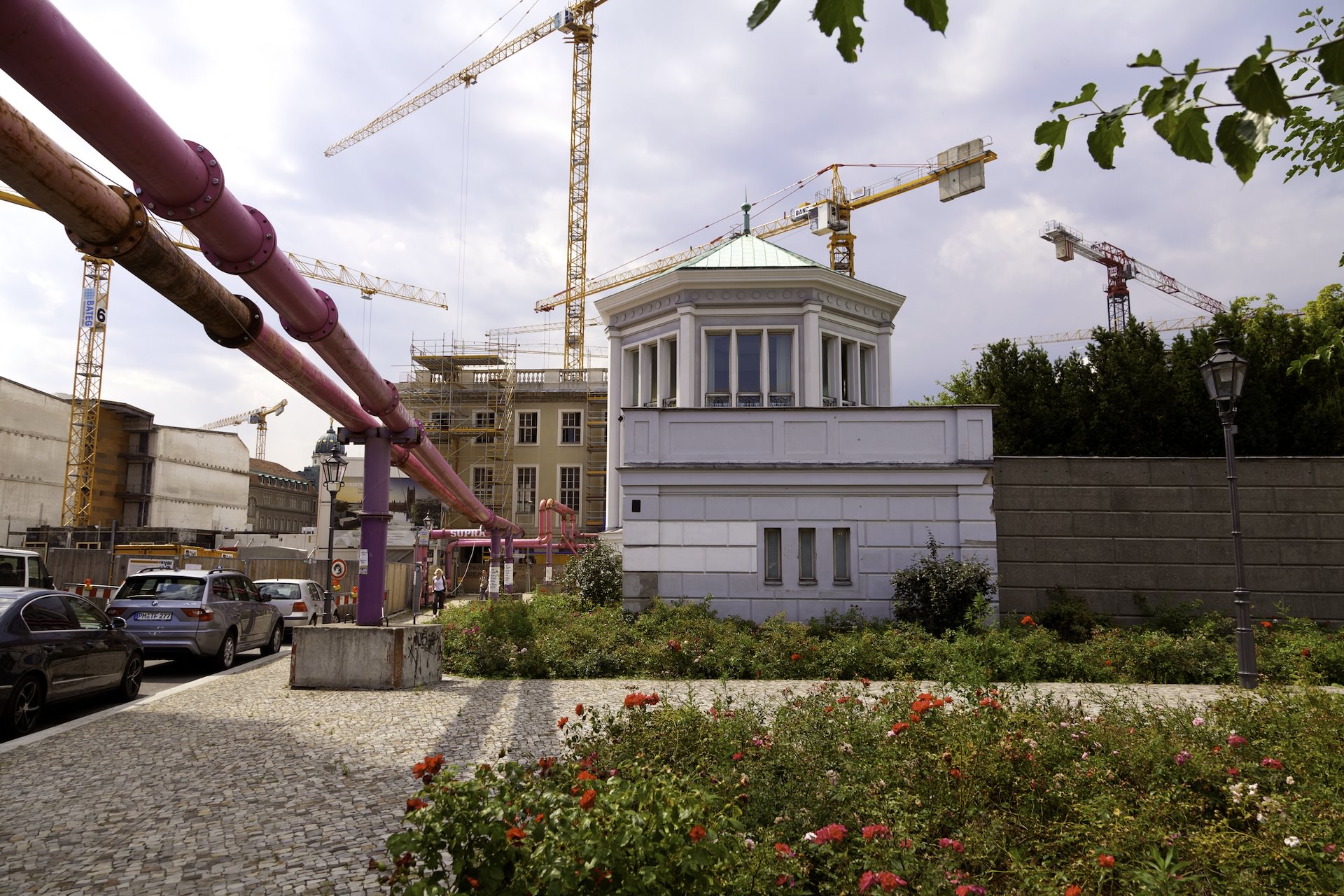
Deafening construction sounds are a constant reminder that the Schinkel Pavillon will soon be blocked off by a new townhouse development. (Photo: Chloé Richard)
-
Elvia Wilk: How did you end up in Berlin?
Nina Pohl: I came to Berlin from Dusseldorf in 2006. At that time everyone in the Rhineland felt we should move to Berlin because it was dying where we were. I was in the second wave of people leaving. It seems like nobody lives in Dusseldorf or Cologne anymore.
At what point did you get in touch with entrepreneur Stephan Landwehr, who initiated using the Schinkel Pavillon as a space to show art?
He asked me to join the project six or seven years ago, and at the beginning we worked on it together. Then he stopped being involved, as he had too much work with the restaurants he owns — Pauly Saal and Grill Royal.
When Landwehr acquired the space, he was particularly interested in the chance to display art in a windowed open room with natural light. Was this one of the things that attracted you as well?
It’s hard to explain. There’s something mystical about the pavilion. The first time I visited was at night, when you can see all the city lights and the skyline. I was impressed by the mood of the space; it has something very particular, very special, almost overwhelming. I didn’t get that feeling from other places in Berlin.
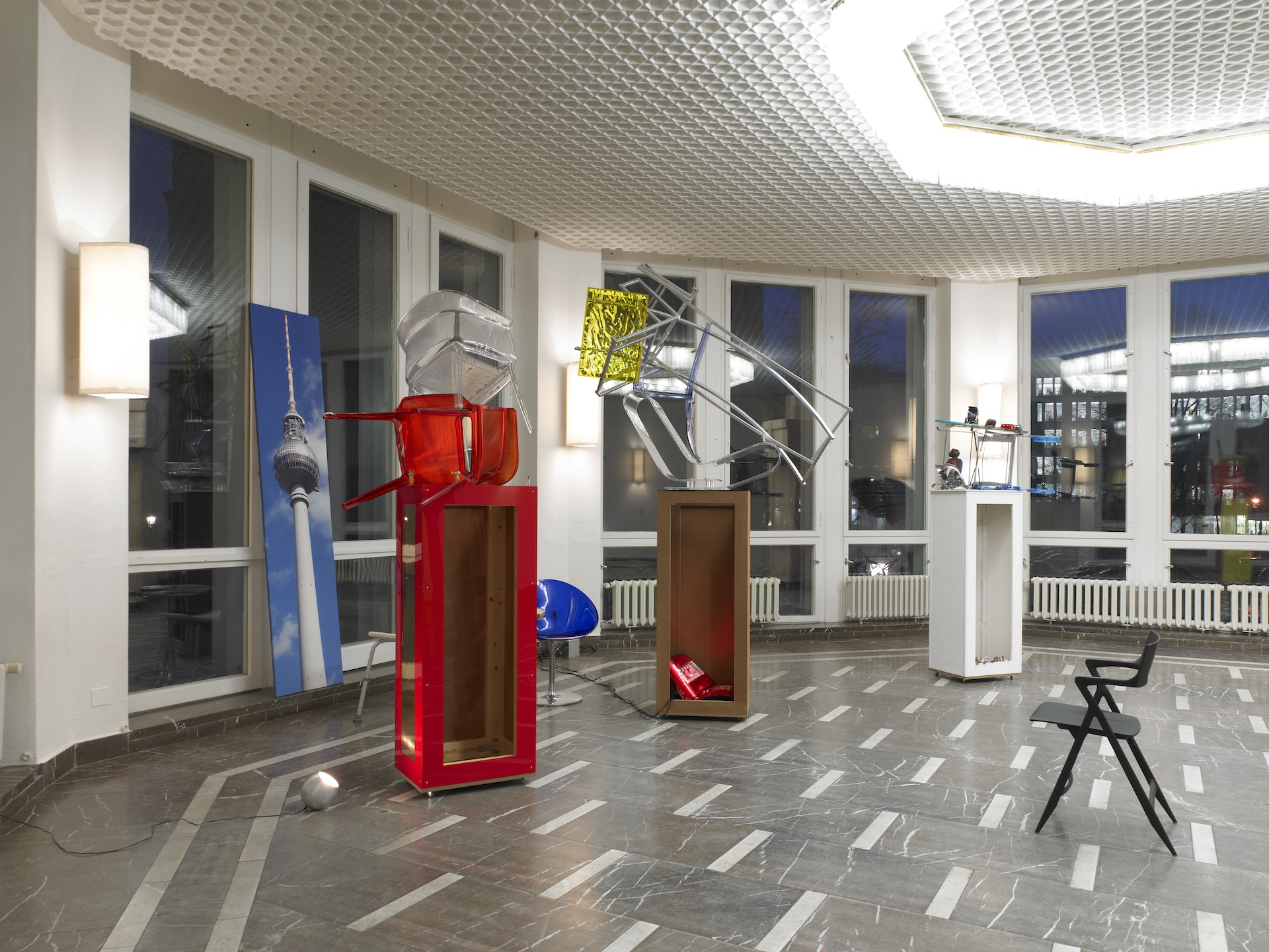
In her 2012 installation “Hallelujah,” artist Isa Genzken played off the pavilion’s views of the city skyline, with visual puns like an image of the Television Tower and a director’s chair facing the vista. (Photo: courtesy Galerie Buchholz, Berlin)
-
Dirk Bell, “LI´ve is LI´ve,” 2009. (Photo courtesy Schinkel Pavillon)
-
To me, the mystical quality you mention is partly due to its multi-layered history. In some ways it’s the epitome of the “Berlin building,” an amalgamation of remnants from various historical moments.
It’s totally Berlin! It’s hard to think of a building that compares. The Schinkel Pavillon also belongs to the Kronprinzenpalais (Crown Prince Palace) nearby on Unter den Linden – we’re in its garden. It was originally a Stadthaus (city hall) built in the seventeenth century, and in the 1920s it housed the first museum of contemporary art in the world – it was actually the template for MoMA. The curator of the Nationalgalerie, Ludwig Justi, was the first curator to make studio visits to meet contemporary artists, gathering their works and curating them in the museum. Justi mostly showed German Expressionism, which was later designated as Entartete Kunst (Degenerate Art) and seized by the Nazis in the thirties. Then the museum was closed, and in 1945 the building was bombed and totally destroyed. Both the Kronprinzenpalais and the pavilion were rebuilt in 1969 by Richard Paulick. He was a very important architect during the DDR, and these two buildings were significant during that time. GDR leader Eric Honecker had his cocktail parties here.
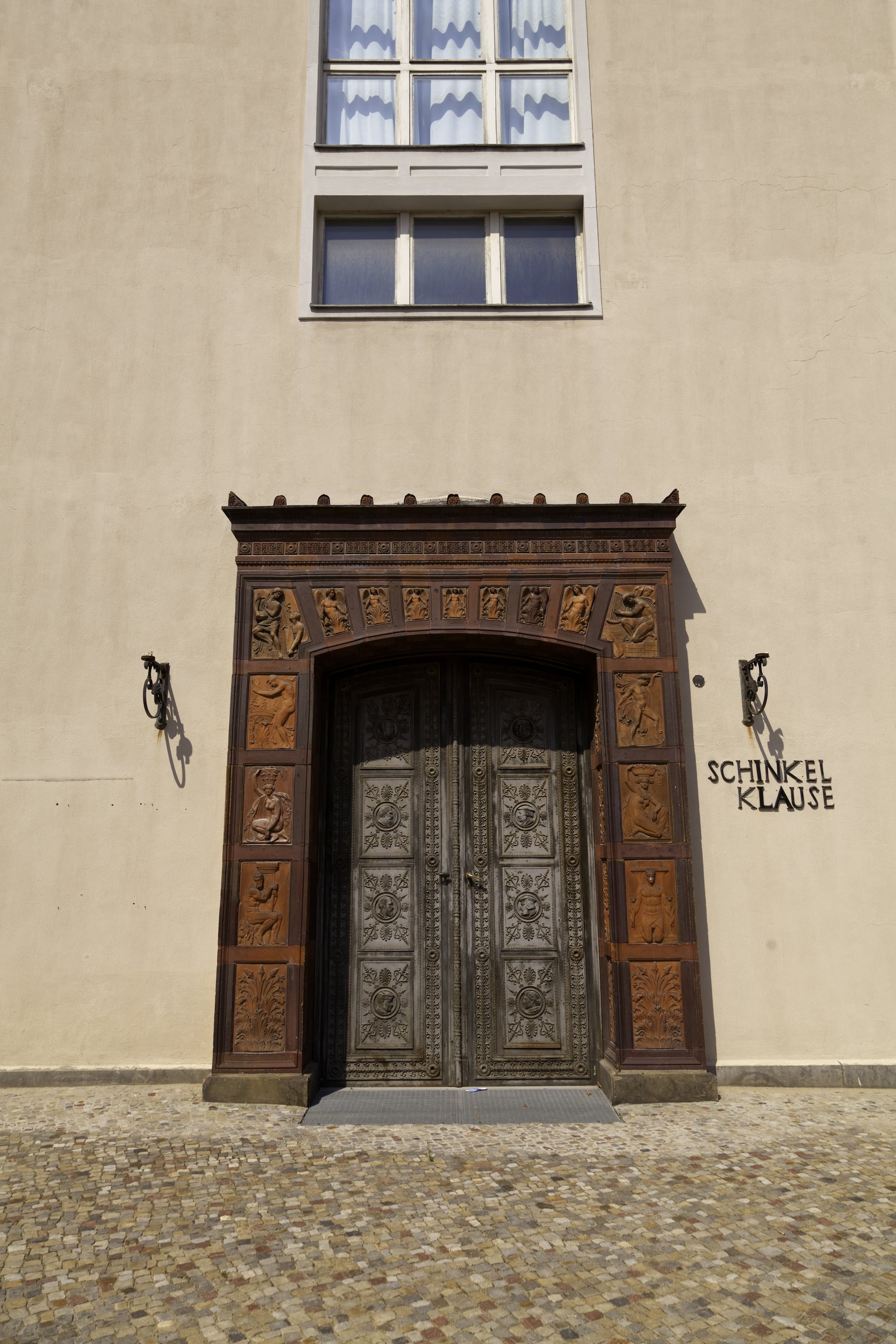
When he built the Schinkel Pavillon in 1969, architect Richard Paulick incorporated terracotta reliefs from Schinkel’s original Bauakademie in its interior and exterior. (Photo: Chloé Richard)
-
So you’re continuing in that tradition?
Absolutely!
And your programming reflects the history of the Kronprinzenpalais, which was not only intended as a place for showing current art but for gathering people together.
Right, that’s why I made the Schinkel Pavillon a registered Kunstverein, part of a German system in which the public can become members and pay an annual fee to support us.
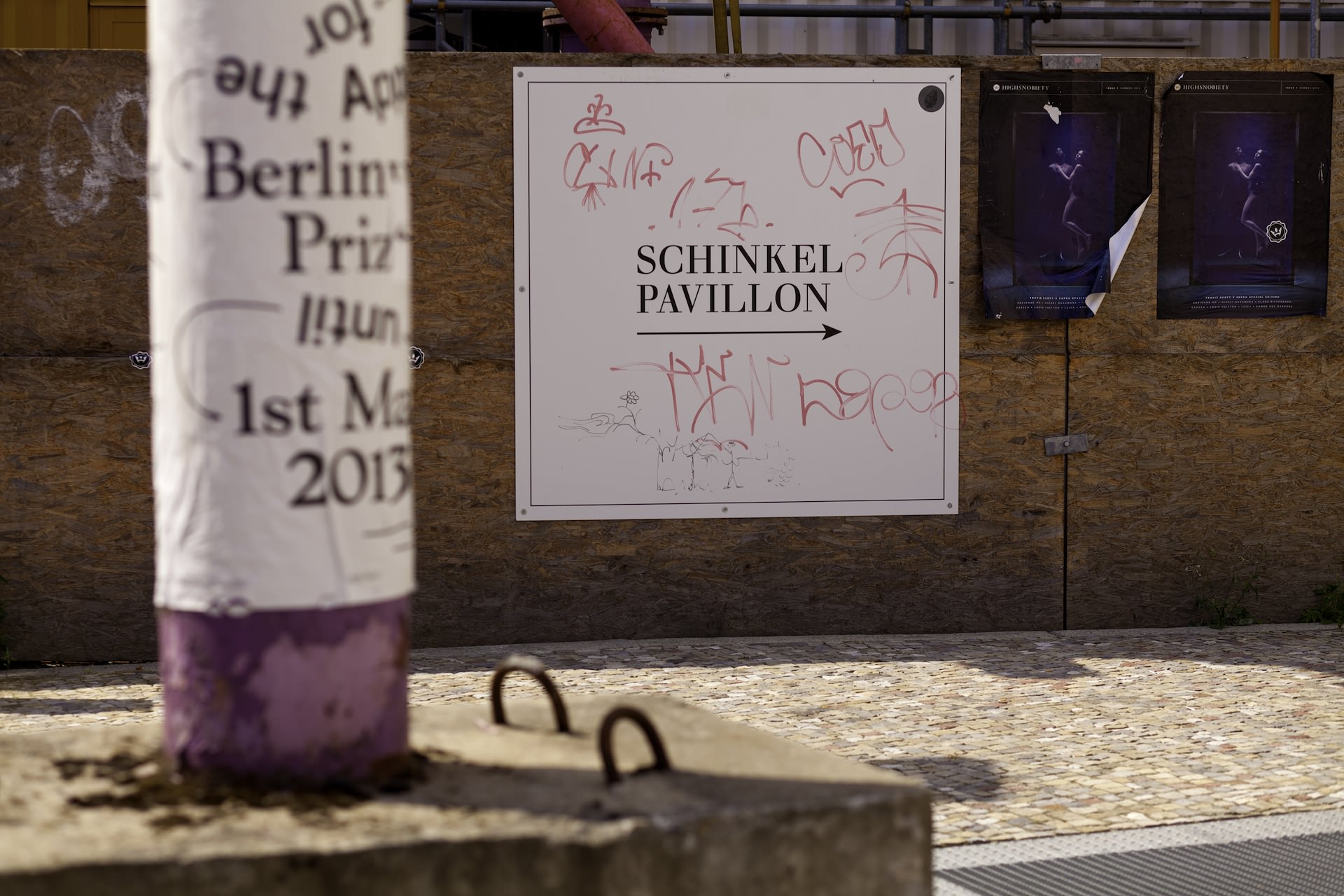
(Photo: Chloé Richard)
-
Would you consider using the pavilion as a commercial gallery space?
I’m not interested. I like to use it as a melting pot, as a platform for social activities, and I don’t want to have a commercial enterprise. I invite the artists I like. It’s very spontaneous. This is an advantage compared to big institutions, because we can react very quickly from one day to another, making a lively program. And of course I like to invite artists who react strongly to the space.
Performances in particular take on a special quality here.
It’s very important to hold live events rather than just putting a nice sculpture in the middle of the room. You have to have a dialogue with the audience, and a performance is the best way to communicate with the city.
»It’s really a pity that every free space in Berlin is being covered with new development.«
For instance, at Cyprien Gaillard’s 2012 show, What it does to your City, he placed classical sculpture in the pavillon, but there was also a performance outside the building – drawing the outside world in.
This was a work that directly addressed the pavilion’s urban environment.
It was a show about how the city is dealing with architecture – destroying or shutting down free places. For example, what is happening here with Schinkel’s Friedrichswerder Church, which is directly visible from the Schinkel Pavillon. Construction is beginning right now on a group of townhouses directly between here and the church, right up against it. It’s a disastrous architecture, this pseudo-nineteenth century building, going at 10,000 euros per square meter to rich Russian expats ... it’s really a pity that every free space in Berlin is being covered with new development.
-
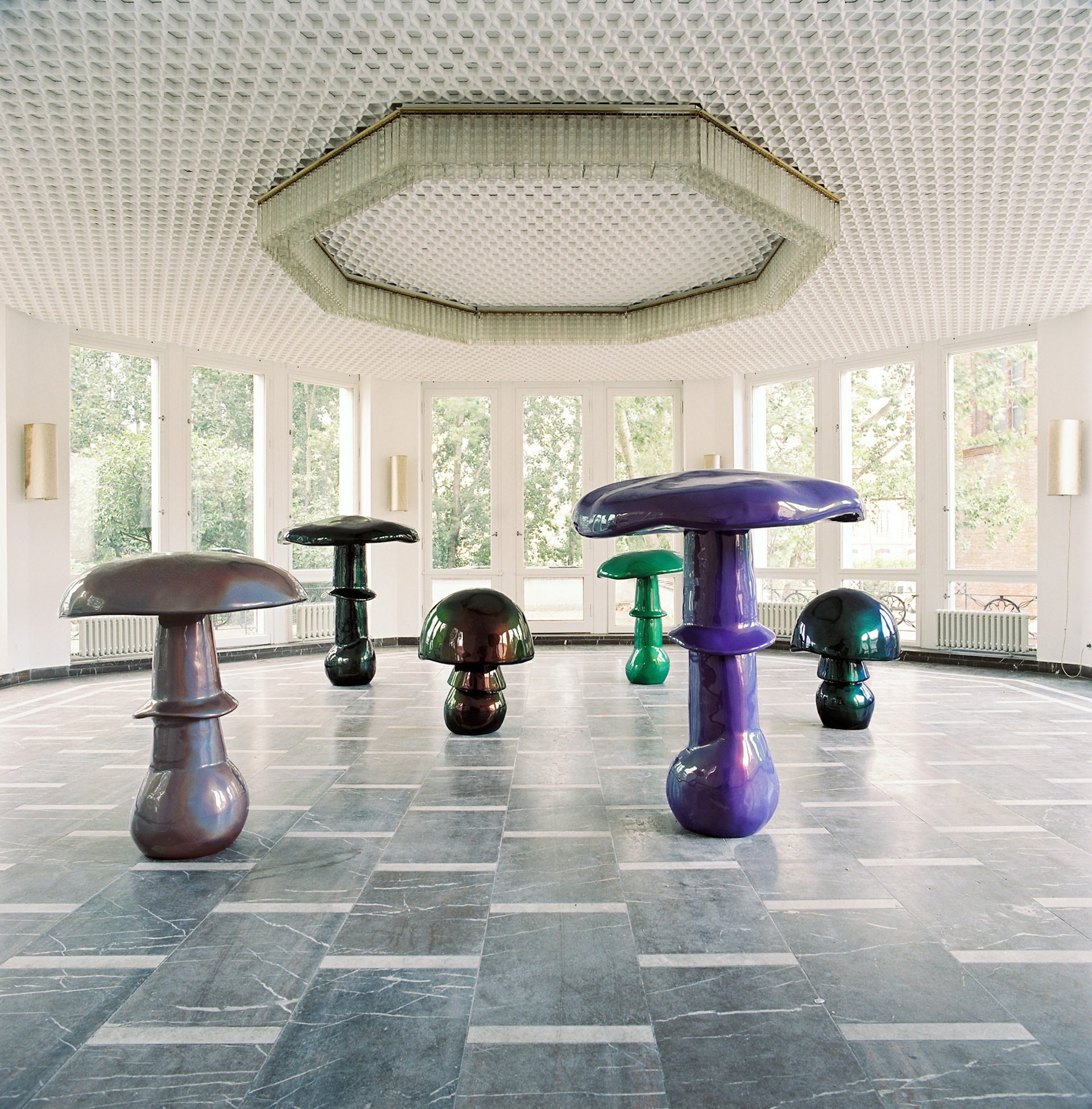
Sylvie Fleury, “Hypnotic Poison,” 2007. (Photo courtesy Schinkel Pavillon)
Saâdane Afif, “The Fairytale Recordings,” performance, 2011. (Photo: Jan Windszus, courtesy Mehdi Chouakri, Berlin / RaebervonStenglin, Zürich)
»I don’t want to have a commercial enterprise. I invite the artists I like.«
-
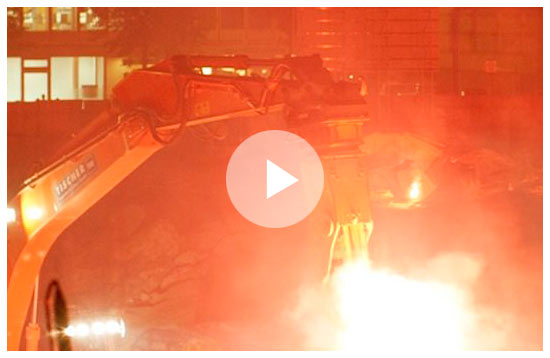
In conjunction with his 2012 exhibition “What it Does to Your City,” Cyprien Gaillard staged a performance in a construction lot adjacent to the Schinkel Pavillon: a choreography of shovel-excavators accompanied by xylophone music.
(Photo: Linus Dessecker , © Cyprien Gaillard , courtesy Sprüth Magers Berlin, London)
(Video: One-minute excerpt from Gaillard’s twenty-minute performance, “What It Does To Your City,” during Berlin Art Week, 2012.)
-
But the area has always been folding back on itself like this, referencing the past — Schinkel’s Church, for instance, was one of Berlin’s first Neo-Gothic buildings; it was already an appropriation of a historical style.
Yes, but what’s strange is that today the area’s history is being used to justify the new construction. At the time when the Friedrichswerder Church was originally built, there were townhouses in the exact area where they’re being built now. Because it’s deemed authentic, it’s possible to justify building townhouses there again. But it’s ridiculous to put that development so near to the church and to destroy the whole view!
You mean plopping this massive high-end apartment block between the church and the pavilion cuts off any visual understanding of historical connections between the two?
At the moment there are still views from every angle of the pavilion – the city itself enters the space. In this little building, there is so much reflection of history – it’s a potpourri of the past. The terracotta reliefs dotting the outside and inside of the Schinkel Pavillon are from Schinkel’s Bauakademie – they are melded into the surface of an East German reconstruction. It’s a collage of art and architecture.
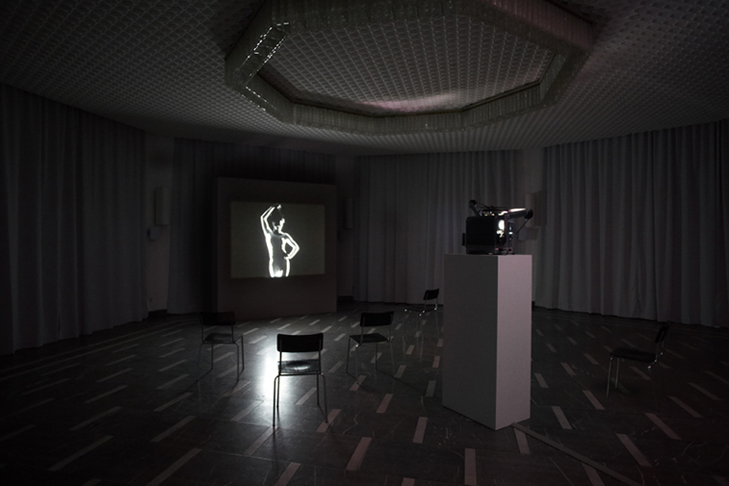
Jeremy Shaw, “Variation FQ,” 2013. (Photo: Nick Ash, courtesy Schinkel Pavillon)
-
Nina Pohl is a Berlin-based artist represented by Sprüth Magers Gallery.
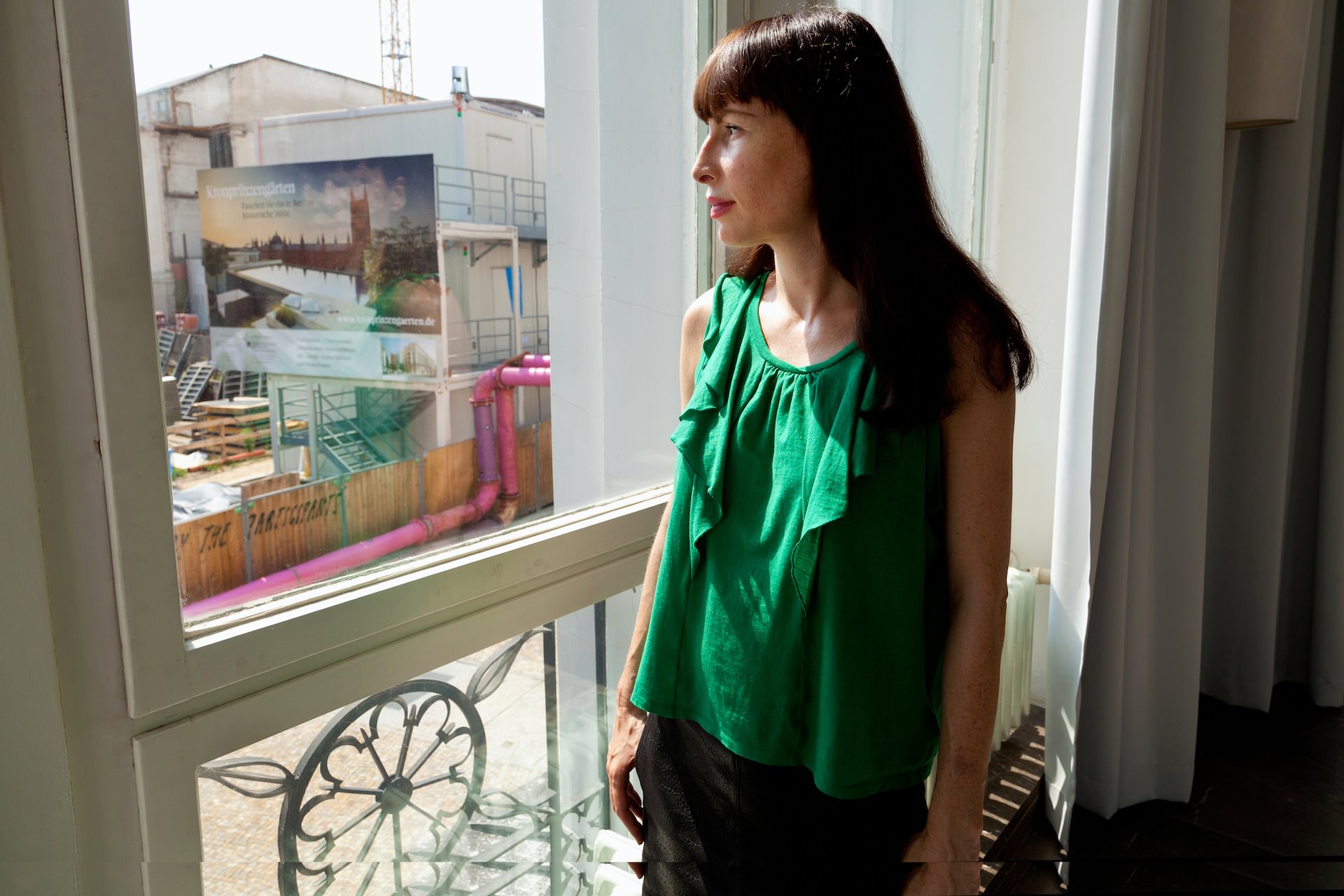
(Photo: Chloé Richard)
»In this little building, there is so much reflection of history«
You’re also an artist. How does your work respond to the experience of working here?
As an artist you’re always alone in your studio, and often you don’t have much conversation with the outside world. But if you are both an artist and curator, you have to see a lot of art, do studio visits, and create strong dialog with other artists. This creates a very rich life for me.
Sounds like you’re staying in Berlin.
Will I stay here? Of course. I’d never drop the pavilion.

-
Search
-
FIND PRODUCTS
PRODUCT GROUP
- Building Materials
- Building Panels
- Building technology
- Façade
- Fittings
- Heating, Cooling, Ventilation
- Interior
- Roof
- Sanitary facilities
MANUFACTURER
- 3A Composites
- Alape
- Armstrong
- Caparol
- Eternit
- FSB
- Gira
- Hagemeister
- JUNG
- Kaldewei
- Lamberts
- Leicht
- Solarlux
- Steininger Designers
- Stiebel Eltron
- Velux
- Warema
- Wilkhahn
-
Follow Us
Tumblr
New and existing Tumblr users can connect with uncube and share our visual diary.
»Tradition is a dare for innovation.«
Alvaro Siza
Keyboard Shortcuts
- Supermenu
- Skip Articles
- Turn Pages
- Contents
